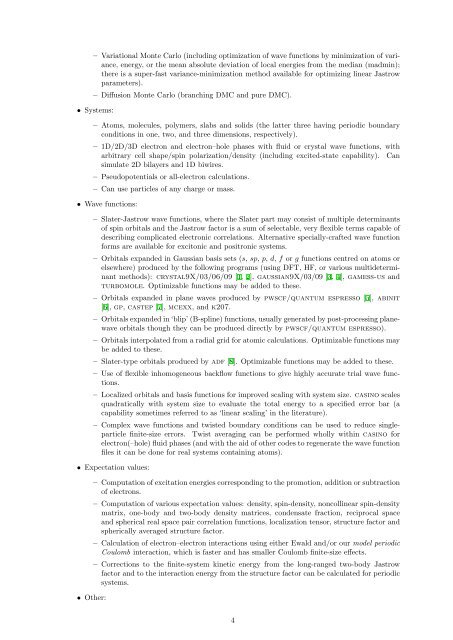CASINO manual - Theory of Condensed Matter
CASINO manual - Theory of Condensed Matter
CASINO manual - Theory of Condensed Matter
You also want an ePaper? Increase the reach of your titles
YUMPU automatically turns print PDFs into web optimized ePapers that Google loves.
– Variational Monte Carlo (including optimization <strong>of</strong> wave functions by minimization <strong>of</strong> variance,<br />
energy, or the mean absolute deviation <strong>of</strong> local energies from the median (madmin);<br />
there is a super-fast variance-minimization method available for optimizing linear Jastrow<br />
parameters).<br />
– Diffusion Monte Carlo (branching DMC and pure DMC).<br />
• Systems:<br />
– Atoms, molecules, polymers, slabs and solids (the latter three having periodic boundary<br />
conditions in one, two, and three dimensions, respectively).<br />
– 1D/2D/3D electron and electron–hole phases with fluid or crystal wave functions, with<br />
arbitrary cell shape/spin polarization/density (including excited-state capability). Can<br />
simulate 2D bilayers and 1D biwires.<br />
– Pseudopotentials or all-electron calculations.<br />
– Can use particles <strong>of</strong> any charge or mass.<br />
• Wave functions:<br />
– Slater-Jastrow wave functions, where the Slater part may consist <strong>of</strong> multiple determinants<br />
<strong>of</strong> spin orbitals and the Jastrow factor is a sum <strong>of</strong> selectable, very flexible terms capable <strong>of</strong><br />
describing complicated electronic correlations. Alternative specially-crafted wave function<br />
forms are available for excitonic and positronic systems.<br />
– Orbitals expanded in Gaussian basis sets (s, sp, p, d, f or g functions centred on atoms or<br />
elsewhere) produced by the following programs (using DFT, HF, or various multideterminant<br />
methods): crystal9X/03/06/09 [1, 2], gaussian9X/03/09 [3, 4], gamess-us and<br />
turbomole. Optimizable functions may be added to these.<br />
– Orbitals expanded in plane waves produced by pwscf/quantum espresso [5], abinit<br />
[6], gp, castep [7], mcexx, and k207.<br />
– Orbitals expanded in ‘blip’ (B-spline) functions, usually generated by post-processing planewave<br />
orbitals though they can be produced directly by pwscf/quantum espresso).<br />
– Orbitals interpolated from a radial grid for atomic calculations. Optimizable functions may<br />
be added to these.<br />
– Slater-type orbitals produced by adf [8]. Optimizable functions may be added to these.<br />
– Use <strong>of</strong> flexible inhomogeneous backflow functions to give highly accurate trial wave functions.<br />
– Localized orbitals and basis functions for improved scaling with system size. casino scales<br />
quadratically with system size to evaluate the total energy to a specified error bar (a<br />
capability sometimes referred to as ‘linear scaling’ in the literature).<br />
– Complex wave functions and twisted boundary conditions can be used to reduce singleparticle<br />
finite-size errors. Twist averaging can be performed wholly within casino for<br />
electron(–hole) fluid phases (and with the aid <strong>of</strong> other codes to regenerate the wave function<br />
files it can be done for real systems containing atoms).<br />
• Expectation values:<br />
• Other:<br />
– Computation <strong>of</strong> excitation energies corresponding to the promotion, addition or subtraction<br />
<strong>of</strong> electrons.<br />
– Computation <strong>of</strong> various expectation values: density, spin-density, noncollinear spin-density<br />
matrix, one-body and two-body density matrices, condensate fraction, reciprocal space<br />
and spherical real space pair correlation functions, localization tensor, structure factor and<br />
spherically averaged structure factor.<br />
– Calculation <strong>of</strong> electron–electron interactions using either Ewald and/or our model periodic<br />
Coulomb interaction, which is faster and has smaller Coulomb finite-size effects.<br />
– Corrections to the finite-system kinetic energy from the long-ranged two-body Jastrow<br />
factor and to the interaction energy from the structure factor can be calculated for periodic<br />
systems.<br />
4

















